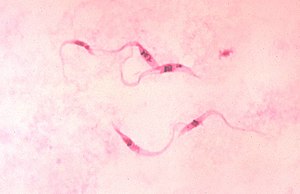Kinetoplastea
| Kinetoplastea | ||||||||||||
|---|---|---|---|---|---|---|---|---|---|---|---|---|

|
||||||||||||
| Systematics | ||||||||||||
|
||||||||||||
| Scientific name | ||||||||||||
| Kinetoplastea | ||||||||||||
| Honigberg , 1963 |
The Kinetoplastea ( Syn .: Kinetoplastida) form a class of flagellated unicellular organisms ( flagellates ); they belong to the Euglenozoa . Many kinetoplasts are parasites .
description
The kinetoplastea have a single large mitochondrion in which the so-called kinetoplast is located: a large amount of fibrillary DNA (kDNA), which is often closely related to the base of the flagellum .
ecology
Many kinetoplastea are parasitic, such as the species Trypanosoma brucei , a parasite in humans that causes sleeping sickness . The carrier here is the tsetse fly . Another type of kinetoplastidea that is dangerous to humans is Trypanosoma cruzi , which causes Chagas disease (see also: Trypanosomes ).
Systematics
Traditionally, the Kinetoplastea were divided into the two suborders Bodonida and Trypanosomida. Adl et al. divide the group based on new findings as follows:
- Prokinetoplastina with Ichthyobodo and Perkinsellia
- Metakinetoplastina
literature
- Sina M. Adl and 27 other authors: The New Higher Level Classification of Eukaryotes with Emphasis on the Taxonomy of Protists. The Journal of Eukaryotic Microbiology, Vol. 52, 2005, pp. 399-451. doi : 10.1111 / j.1550-7408.2005.00053.x .
- Dmitri A Maslov, Sergei A Podlipaev and Julius Lukeš: Phylogeny of the Kinetoplastida: Taxonomic Problems and Insights into the Evolution of Parasitism. Memórias do Instituto Oswaldo Cruz, Volume 6, 2001, pp. 397-402.